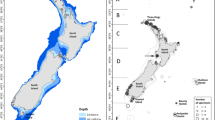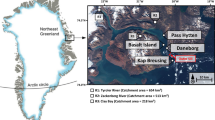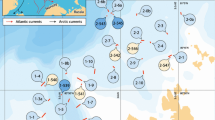Abstract
Non-destructive photographic techniques are valuable for surveying benthic epifauna in sensitive areas. Inherent in these techniques, however, are selectivity biases related to the scale at which surveys are conducted. Such biases have not been addressed for surveys of marine benthos. The present study surveyed epifaunal assemblages at two depths (8 m and 20 m) and three locations close to Rothera Point, Adelaide Island, Antarctica. Two scales of photographic sampling were employed in order to encompass a broad range of taxon sizes and distributions, and their parallel use allowed qualitative and quantitative comparisons to be made between results from each scale. An additional physical sampling element was incorporated to assess sessile cryptic assemblages. A total of 79 faunal taxa from 10 phyla, together with 6 algal taxa, were recorded in the survey. Echinoderms were the most speciose group at both photographic scales, whereas cryptic assemblages were dominated by bryozoans. There were clear resolution-related differences between scales but all three methods revealed pronounced differences in assemblages by depth and location. Assemblages at both depths were notable for consistently high densities (~100 individuals m−2) of the regular echinoid Sterechinus neumayeri, and at 8 m for high densities (~100 individuals m−2) of the limpet Nacella concinna. The results emphasise the general requirement for sampling methodologies to be matched to the size spectra of the organisms under study and, more specifically, highlight the need for studies to assess the relative importance of biotic and physical factors in structuring the Antarctic benthos.








Similar content being viewed by others
References
Alves FMA, Chicharo LM, Serrao E, Abreu AD (2001) Algal cover and sea urchin spatial distribution at Madeira Island (NE Atlantic). Sci Mar 65:383–392
Amsler CD, McClintock JB, Baker BJ (1999) An Antarctic feeding triangle: defensive interactions between macroalgae, sea urchins, and sea anemones. Mar Ecol Prog Ser 183:105–114
Andrew NL, Mapstone BD (1987) Sampling and the description of spatial pattern in marine ecology. Oceanogr Mar Biol 25:39–90
Andrew NL, Underwood AJ (1993) Density-dependent foraging in the sea urchin Centrostephanus rodgersii on shallow subtidal reefs in New South Wales, Australia. Mar Ecol Prog Ser 99:89–98
Arntz WE, Brey T, Gallardo VA (1994) Antarctic zoobenthos. Oceanogr Mar Biol Annu Rev 32:241–304
Ayling AM (1981) The role of biological disturbance in temperate subtidal encrusting communities. Ecology 62:830–847
Barnes DKA (1995a) Sublittoral epifaunal communities at Signy Island, Antarctica.1. The ice foot zone. Mar Biol 121:555–563
Barnes DKA (1995b) Sublittoral epifaunal communities at Signy Island, Antarctica.2. Below the ice-foot zone. Mar Biol 121:565–572
Barnes DKA (1999) The influence of ice on polar nearshore benthos. J Mar Biol Assoc UK 79:401–407
Barnes DKA, Brockington S (2003) Zoobenthic biodiversity, biomass and abundance at Adelaide Island, Antarctica. Mar Ecol Prog Ser 249:145–155
Barnes DKA, Rothery P, Clarke A (1996) Colonisation and development in encrusting communities from the Antarctic intertidal and sublittoral. J Exp Mar Biol Ecol 196:251–265
Bernhardt SP, Griffing LR (2001) An evaluation of image analysis at benthic sites based on color segmentation. Bull Mar Sci 69:639–653
Bohnsack JA (1979) Photographic quantitative sampling of hard-bottom benthic communities. Bull Mar Sci 29:242–252
Bosch I, Beauchamp KA, Steele ME, Pearse JS (1987) Development, metamorphosis, and seasonal abundance of embryos and larvae of the Antarctic sea urchin Sterechinus neumayeri. Biol Bull 173:126–135
Breitburg DL (1996) Consumer mobility and the relative importance of consumption and competition following physical disturbance. Mar Ecol Prog Ser 138:83–92
Brockington S, Clarke A (2001) The relative influence of temperature and food on the metabolism of a marine invertebrate. J Exp Mar Biol Ecol 258:87–99
Brockington S, Clarke A, Chapman ALG (2001) Seasonality of feeding and nutritional status during the austral winter in the Antarctic sea urchin Sterechinus neumayeri. Mar Biol 139:127–138
Chapman ARO (1981) Stability of sea urchin dominated barren grounds following destructive grazing of kelp in St. Margarets Bay, eastern Canada. Mar Biol 62:307–311
Clarke A, Johnston NM (2003) Antarctic marine benthic diversity. Oceanogr Mar Biol 41:47–114
Clarke KR, Warwick RM (2001) Change in marine communities: an approach to statistical analysis. PRIMER-E, Plymouth
Cranmer TL, Ruhl HA, Baldwin RJ, Kaufmann RS (2003) Spatial and temporal variation in the abundance, distribution and population structure of epibenthic megafauna in Port Foster, Deception Island. Deep-Sea Research. Part II.Top Stud Oceanogr 50:1821–1842
Dayton PK (1985) Ecology of kelp communities. Annu Rev Ecol Syst 16:215–245
Dayton PK (1989) Interdecadal variation in an Antarctic sponge and its predators from oceanographic climate shifts. Science 245:1484–1486
Dayton PK (1990) Polar benthos. In: Smith WO (ed) Polar oceanography. Academic, London, pp 631–685
Elliot JM (1979) Methods for the analysis of samples of benthic invertebrates. Ferry House, UK
Elner RW, Vadas RL (1990) Inference in ecology—the sea-urchin phenomenon in the northwestern Atlantic. Am Nat 136:108–125
Foster MS, Harrold C, Hardin DD (1991) Point versus hoto quadrat estimates of the cover of sessile marine organisms. J Exp Mar Biol Ecol 146:193–203
Fraser KPP, Clarke A, Peck LS (2002) Feast and famine in Antarctica: seasonal physiology in the limpet Nacella concinna. Mar Ecol Prog Ser 242:169–177
Gray CA, Bell JD (1986) Consequences of two common techniques for sampling vagile macrofauna associated with the seagrass Zostera capricorni. Mar Ecol Prog Ser 28:43–48
Gutt J, Starmans A, Dieckmann G (1996) Impact of iceberg scouring on polar benthic habitats. Mar Ecol Prog Ser 137:311–316
Hagen NT (1995) Recurrent destructive grazing of successionally immature kelp forests by green sea urchins in Vestfjorden, northern Norway. Mar Ecol Prog Ser 123:95–106
Hawkins SJ, Hartnoll RG (1983) Grazing of Intertidal Algae by Marine Invertebrates. Oceanogr Mar Biol 21:195-282
Hill NA, Blount C, Poore AGB, Worthington D, Steinberg PD (2003) Grazing effects of the sea urchin Centrostephanus rodgersii in two contrasting rocky reef habitats: effects of urchin density and its implications for the fishery. Mar Freshwater Res 54:691–700
Holme NA, McIntyre AD (1984) Methods for the study of marine benthos. Blackwell Scientific, Oxford
Hunt HL, Scheibling RE (1997) Role of early post-settlement mortality in recruitment of benthic marine invertebrates. Mar Ecol Prog Ser 155:269–301
Kennelly SJ, Underwood AJ (1985) Sampling of small invertebrates on natural hard substrata in a sublittoral kelp forest. J Exp Mar Biol Ecol 89:55–67
Kim D (2001) Seasonality of marine algae and grazers of an Antarctic rocky intertidal, with emphasis on the role of the limpet Nacella concinna Strebel (Gastropoda: Patellidae). Ber Polar Meeresfursch 397
Kirkwood JM, Burton HR (1988) Macrobenthic Species Assemblages in Ellis Fjord, Vestfold Hills, Antarctica. Mar Biol 97:445–457
Kitching JA, Thain VM (1982) The ecological impact of the sea urchin Paracentrotus lividus (Lamarck) in Lough Ine, Ireland. Phil Trans R Soc London Ser B 300:513–552
Leinaas HP, Christie H (1996) Effects of removing sea urchins ( Strongylocentrotus droebachiensis): stability of the barren state and succession of kelp forest recovery in the east Atlantic. Oecologia 105:524–536
Levin SA (1992) The problem of pattern and scale in ecology. Ecology 73:1943–1967
Lubchenco J (1983) Littorina and Fucus —effects of herbivores, substratum heterogeneity, and plant escapes during succession. Ecology 64:1116–1123
McIntyre AD (1956) Estimating marine benthos. J Mar Biol Assoc UK 35:419–429
Meese RJ, Tomich PA (1992) Dots on the rocks—a comparison of percent cover estimation methods. J Exp Mar Biol Ecol 165:59–73
Mileikovsky SA (1971) Types of larval development in marine bottom invertebrates, their distribution and ecological significance: a re-evaluation. Mar Biol 10:193–213
Morin A (1985) Variability of density estimates and the optimization of sampling programs for stream benthos. Can J Fish Aquat Sci 42:1530–1534
Pearse JS, McClintock JB, Bosch I (1991) Reproduction of Antarctic benthic marine-invertebrates—tempos, modes, and timing. Am Zool 31:65–80
Pechenik JA (1999) On the advantages and disadvantages of larval stages in benthic marine invertebrate life cycles. Mar Ecol Prog Ser 177:269–297
Pihl L, Rosenberg R (1982) Production, abundance, and biomass of mobile epibenthic marine fauna in shallow waters, western Sweden. J Exp Mar Biol Ecol 57:273–301
Poulin E, Feral JP (1996) Why are there so many species of brooding Antarctic echinoids? Evolution 50:820–830
Propp MV (1970) The study of the bottom fauna at Haswell Islands by SCUBA diving. In: Holdgate M (ed) Antarctic ecology. Academic, London, pp 239–241
Roberts DE, Fitzhenry SR, Kennelly SJ (1994) Quantifying subtidal macrobenthic assemblages on hard substrata using a jump camera method. J Exp Mar Biol Ecol 177:157–170
Sammarco PW (1982) Effects of Grazing by Diadema antillarum Philippi (Echinodermata, Echinoidea) on Algal Diversity and Community Structure. J Exp Mar Biol Ecol 65:83–105
Scheibling RE (1996) The role of predation in regulating sea urchin populations in eastern Canada. Oceanol Acta 19:421–430
Scheibling RE, Hennigar AW, Balch T (1999) Destructive grazing, epiphytism, and disease: the dynamics of sea urchin—kelp interactions in Nova Scotia. Can J Fish Aquat Sci 56:2300–2314
Smith F, Witman JD (1999) Species diversity in subtidal landscapes: maintenance by physical processes and larval recruitment. Ecology 80:51–69
Stanwell-Smith D, Barnes DKA (1997a) Benthic community development in Antarctica: Recruitment and growth on settlement panels at Signy Island. J Exp Mar Biol Ecol 212:61–79
Stanwell-Smith D, Barnes DKA (1997b) Benthic community development in Antarctica: recruitment and growth on settlement panels at Signy Island. J Exp Mar Biol Ecol 212:49–67
Stanwell-Smith D, Peck LS, Clarke A, Murray AWA, Todd CD (1999) The distribution, abundance and seasonality of pelagic marine invertebrate larvae in the maritime Antarctic. Phil Trans R Soc London Ser B 354:471–484
Stretch JJ (1985) Quantitative sampling of demersal zooplankton—reentry and airlift dredge sample comparisons. J Exp Mar Biol Ecol 91:125–136
Teixido N, Garrabou J, Arntz WE (2002) Spatial pattern quantification of Antarctic benthic communities using landscape indices. Mar Ecol Prog Ser 242:1–14
Turner SJ, Todd CD (1991) The Effects of Gibbula cineraria (L), Nucella lapillus (L) and Asterias rubens (L) on developing epifaunal assemblages. J Exp Mar Biol Ecol 154:191–213
Underwood AJ, Chapman MG, Connell SD (2000) Observations in ecology: you can’t make progress on processes without understanding the patterns. J Exp Mar Biol Ecol 250:97–115
Vevers HG (1952) A photographic survey of certain areas of the sea floor near Plymouth. J Mar Biol Assoc UK 31:215–221
Wiencke C (1996) Recent advances in the investigation of Antarctic macroalgae. Polar Biol 16:231–240
Wright JT, Steinberg PD (2001) Effect of variable recruitment and post-recruitment herbivory on local abundance of a marine alga. Ecology 82:2200–2215
Acknowledgments
I thank A. Clarke, D. Barnes and L. Peck, for valuable critical input throughout the study, and all in the marine team at Rothera research station, particularly P. Horne and R. Piper, for diving support. Two anonymous referees suggested changes which improved an earlier version of the manuscript.
Author information
Authors and Affiliations
Corresponding author
Additional information
Communicated by J.P. Thorpe, Port Erin
Rights and permissions
About this article
Cite this article
Bowden, D.A. Quantitative characterization of shallow marine benthic assemblages at Ryder Bay, Adelaide Island, Antarctica. Marine Biology 146, 1235–1249 (2005). https://doi.org/10.1007/s00227-004-1526-0
Received:
Accepted:
Published:
Issue Date:
DOI: https://doi.org/10.1007/s00227-004-1526-0




